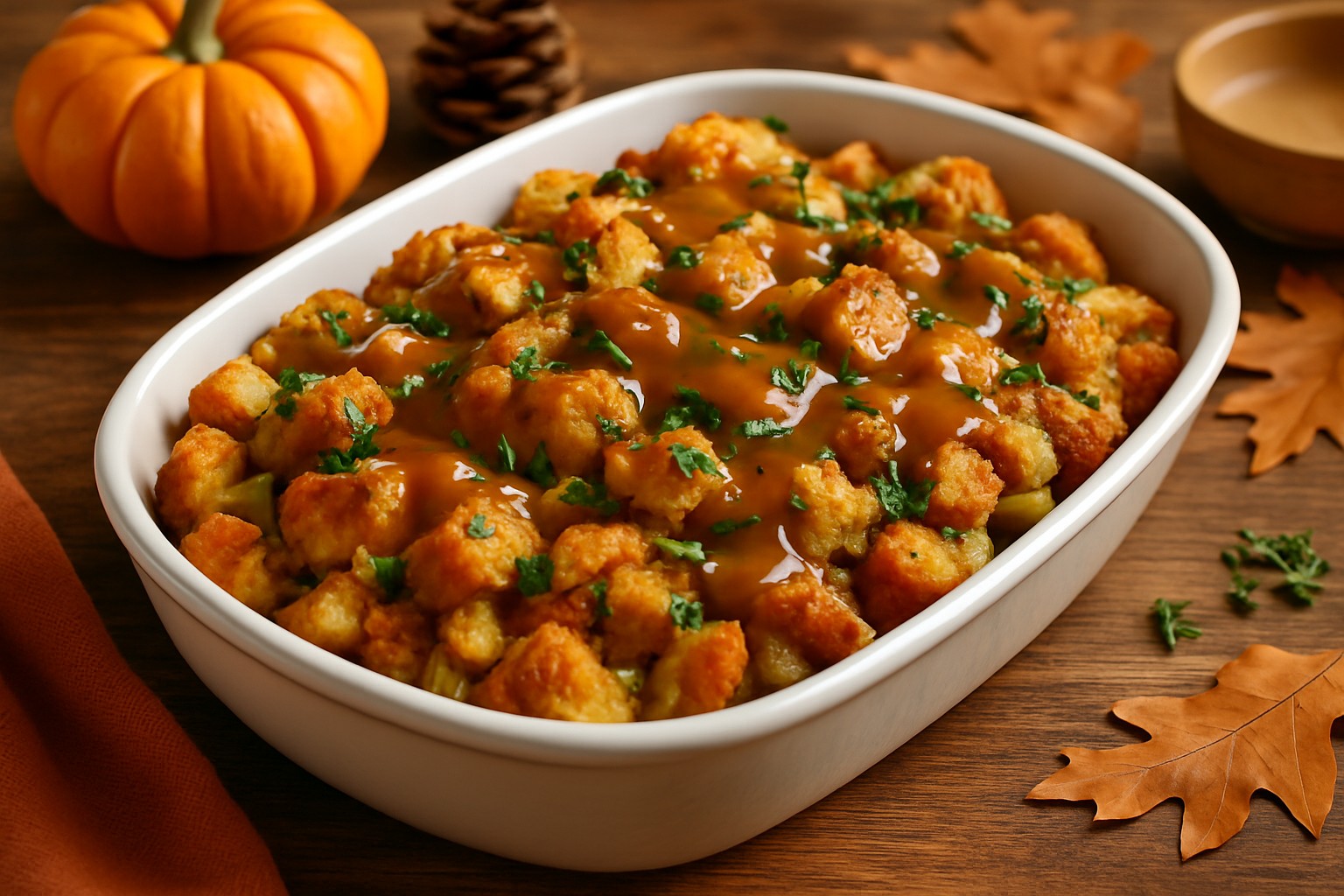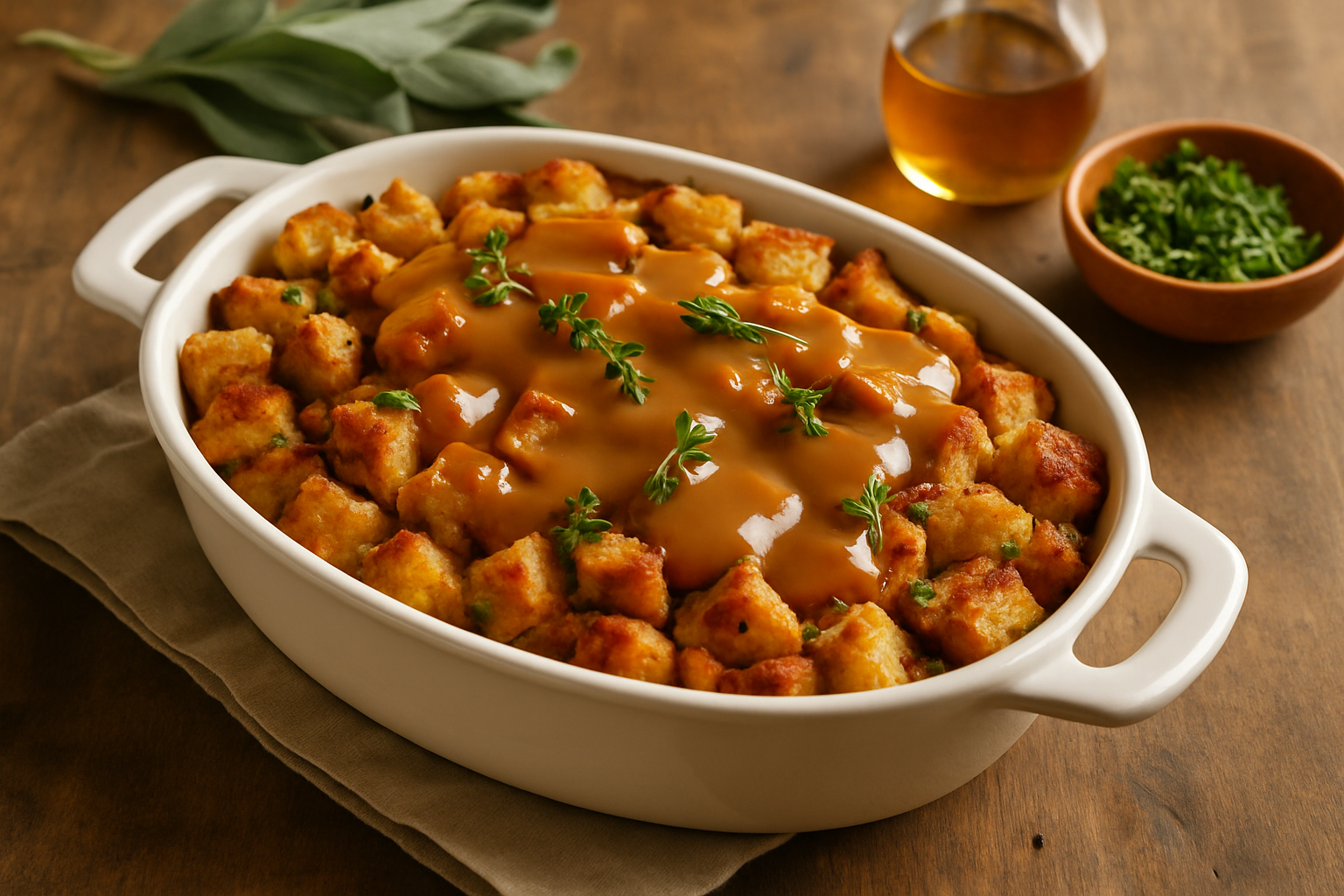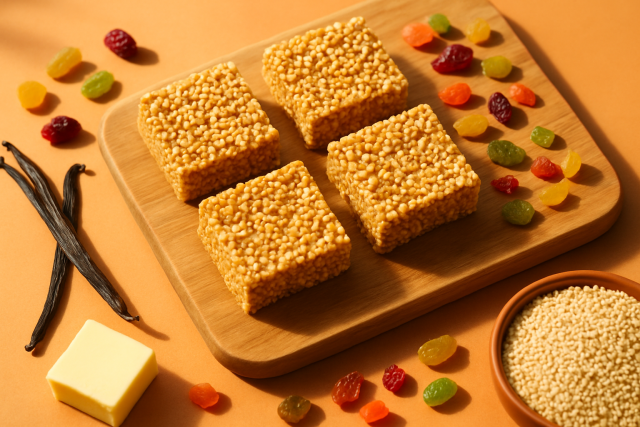How To Cook Stuffing With Gravy That Stays Moist

Stuffing with gravy is a timeless favorite, but getting that perfect moistness can be a bit of an art. If it is too dry, it crumbles as if it’s had a rough day. If it’s too wet, it might lose some of its magic.
Taking a Closer Look at the Basics of Stuffing and Gravy
Stuffing usually involves bread or grains tossed with herbs, veggies and occasionally a bit of meat. It’s designed to soak up all those delicious flavors as it cooks—kind of like a tasty little sponge. Gravy is a savory sauce made from meat drippings, broth and thickeners that brings everything to life.
- Common stuffing ingredients often include day-old bread, onions, celery, fresh herbs like sage and thyme and sometimes sausage or nuts. These are basically all the good stuff you want for cozy flavors.
- Gravies can vary widely. You might have the classic brown turkey gravy that everyone expects or you could try more adventurous creamy mushroom or herb-flavored varieties that add a little extra oomph.
- The type of bread you choose really affects how the stuffing holds onto moisture. Denser breads tend to soak up more liquid which can be a real lifesaver when you want that perfect texture.
- Fat in the gravy plays a sneaky but important role by coating the bread bits and helping your stuffing stay rich and moist. No one wants a dry bite.
- Getting the hydration just right is trickier than it sounds. There’s a fine line between perfectly moist and a soggy mess so a little patience and care go a long way.
- Adding herbs and spices boosts flavor without adding extra moisture or calories. This means maximum taste with none of the guilt.
- Roasting vegetables before stirring them in seems to deepen their flavor. This gives your stuffing extra depth without turning it into a soggy vegetable stew.
The Challenges of Getting Moist Stuffing Just Right with Gravy
Nailing the perfect moisture level in stuffing with gravy can be a bit of an art form. More often than not cooks find themselves stuck with dry stuffing that won’t soak up enough liquid or ends up overcooked and crumbly. On the flip side drowning it in gravy usually makes the whole thing soggy and frankly a little sad. Another headache is when the flavors aren’t evenly distributed. You get some bites swimming in gravy while others taste bland. Watching the oven temperature and cooking time closely really pays off. Too hot and your stuffing turns into a dry mess. Too little heat or undercooking, especially with raw ingredients like sausage, can leave you with a mushy and unsafe dish.
"Nailing the moisture level is more important than you might think when you are working with stuffing and gravy. It’s the secret sauce that really shapes the texture and lets those flavors meld perfectly. The goal? A stuffing that’s moist enough to stay juicy but still firm enough to hold its shape without turning into a soggy mess — a balance I’ve found can make or break the whole dish." — Chef Anna Rivers, Culinary Expert
Key Ingredients for Moist, Flavor-Packed Stuffing with Gravy
The secret to achieving moist stuffing with gravy comes down to picking the right bread, quality fats and a broth that packs a punch. Dense breads like sourdough or French bread soak up the liquids without turning into a soggy mess. A bit of butter and olive oil boost the richness and help lock in moisture. Homemade broth brings a depth of flavor you cannot beat. Fresh herbs such as thyme, sage and parsley add comforting fragrant notes that make you smile.
| Ingredient | Moisture Contribution | Best Gravy Components |
|---|---|---|
| Day-old French Bread | Soaks up liquid like a champ without turning into a sad, mushy mess | Turkey or chicken drippings-based gravy with just the right thickness to keep things cozy |
| Sourdough Bread | Its dense crumb clings onto moisture longer than you would expect, holding everything together nicely | Herb-infused brown gravy with a pat of butter that melts just so |
| Butter or Olive Oil | Adds a luscious richness and gives the bread a nice coating to lock in moisture | Roux-based gravy that’s smooth and comforting, like a warm hug for your taste buds |
| Homemade Broth | Brings in natural flavors with a salt level that doesn’t overpower, striking a fine balance | Opt for reduced-sodium broths—it’s a subtle trick that really pays off |
| Fresh Herbs (sage, thyme) | Packs a flavorful punch without making the stuffing soggy or altering moisture | Toss fresh herbs into your gravy to lift it with a lovely, inviting aroma |
| Cornstarch or Flour | Thickens gravy just right so your stuffing stays pleasantly firm, not sad and soggy | Helps the gravy cling like a champ, preventing any unwanted slip and slide |
A Clear, Step-By-Step Guide to Making Moist Stuffing with Gravy You’ll Actually Love
- Prepare the bread base: Slice day-old bread into even cubes about an inch thick and bake them in the oven at 300°F for around 10 minutes. The goal is to dry them out just enough so they become golden and a bit crisp but not rock-hard.
- Sauté vegetables: In a skillet, gently cook diced onions and celery or any other veggies you like in butter until they soften and turn translucent. This step brings out their natural sweetness without making them soggy.
- Mix stuffing ingredients: Grab a big bowl and combine the toasted bread cubes, your sautéed veggies, fresh herbs and any seasonings you prefer.
- Make the gravy: Deglaze the pan with some broth while adding any drippings if you have them. Then slowly thicken the gravy with a roux or a bit of cornstarch until it lightly coats the back of a spoon—smooth and silky not gluey.
- Hydrate stuffing: Gradually stir warm gravy into the bread mixture. You want moist tender bread that still holds its shape not mushy. It takes a bit of practice but you will get the hang of it.
- Bake the stuffing: Transfer the mix into a greased baking dish, cover it with foil and bake at 350°F for 30 minutes. Remove the foil for the last 10 minutes so the top becomes perfectly golden and crisp—everyone loves a little crunch.
- Check moisture level: Give the stuffing a gentle press; it should feel moist but not watery. If it seems dry add a splash more gravy before serving.
- Serve immediately: Stuffing tastes best when it’s warm and fresh locking in all those flavors and textures. Waiting usually leads to soggy disappointment.
- Store leftovers properly: Keep any extras tightly sealed in an airtight container in the fridge. When reheating add a splash of gravy to restore moisture—it’s almost as good the second time around.

Perfectly cooked stuffing with moist gravy served fresh from the oven, garnished with fresh thyme and parsley.
Keep dryness at bay by making sure the bread is nicely toasted—think golden and crisp but definitely not burnt. When adding gravy, pour it slowly and gradually so you don’t end up drowning your dish. Keep the oven temperature comfortably moderate rather than cranking it up and risking a culinary disaster. Near the end of baking, peel back the foil to let the top crisp up perfectly while still retaining the right moisture balance.
Different Ways to Cook Stuffing That Actually Stays Moist (No More Dry Bites!)
- Baking stuffing inside the bird tends to soak up rich savory meat juices but calls for careful timing to make sure it cooks evenly and stays moist.
- Cooking stuffing separately in a casserole gives you more control over moisture and texture but misses some of the deep flavor from the bird.
- Using slow cookers usually results in moist stuffing since it cooks low and slow but you might find yourself daydreaming about a crispy top that never shows up.
- Stovetop methods are quick and do the trick for smaller batches but the texture can shift depending on how you juggle the heat—tricky but manageable.
- When reheating stuffing, keeping it covered with a little extra gravy or broth helps lock in moisture and saves it from drying out which I’ve found is a game changer.
Each method has its own perks and quirks when it comes to keeping moisture just right. Cooking inside the bird usually packs in richer flavor, though it can sometimes result in a bit of uneven cooking. Using external casseroles lets you keep a better handle on moisture, but you might miss out on some of those tasty drippings that make the dish sing. Slow cookers do a great job of locking in moisture, though don’t expect any crispy bits there. Stovetop cooking is a speedy option, but it definitely demands your full attention.
Frequent Mistakes and How to Dodge Them Like a Pro
- Cooking stuffing for too long which dries out the bread and leaves it tough as a boot.
- Pouring on too much gravy turning your stuffing into a soggy unappealing mess.
- Using soft or stale bread that won’t soak up moisture properly is a rookie mistake.
- Skipping or skimping on seasoning results in stuffing so bland it might as well be plain toast.
- Not keeping a close eye on oven temperature or humidity can throw off the whole baking process.
- Tossing in watery vegetables without giving them a quick cook first leads to a soggier than expected result.
- Forgetting to let the stuffing rest before serving even though a little patience goes a long way in balancing moisture.
If the stuffing with gravy feels a touch dry, stir in some warm broth or extra gravy and gently reheat it covered on low heat. A sprinkle of fresh herbs can lift the flavor or try slipping in a small pat of butter to give the texture a richer and more indulgent feel during the meal.




